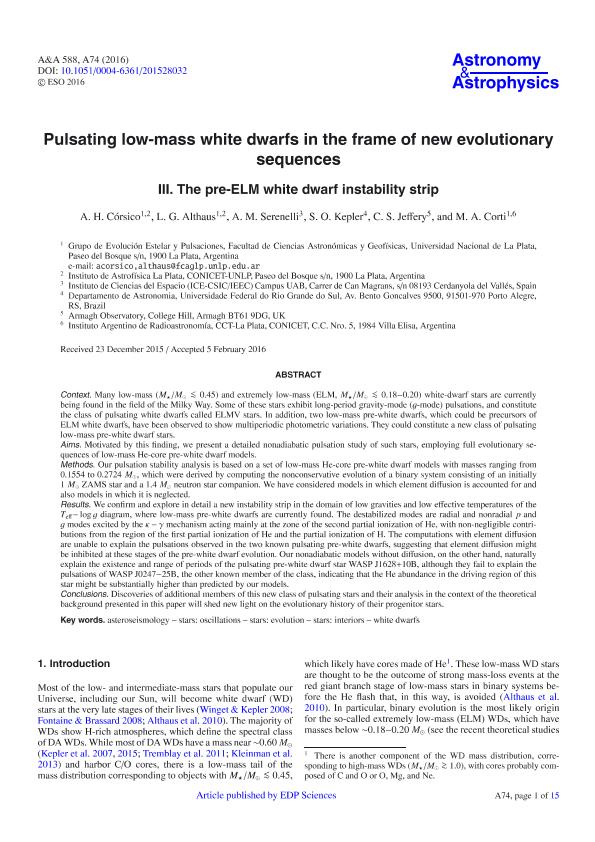Mostrar el registro sencillo del ítem
dc.contributor.author
Corsico, Alejandro Hugo

dc.contributor.author
Althaus, Leandro Gabriel

dc.contributor.author
Serenelli, A.M.
dc.contributor.author
Kepler, S. O.

dc.contributor.author
Jeffery, C.S.
dc.contributor.author
Corti, Mariela Alejandra

dc.date.available
2023-11-14T13:49:22Z
dc.date.issued
2016-04
dc.identifier.citation
Corsico, Alejandro Hugo; Althaus, Leandro Gabriel; Serenelli, A.M.; Kepler, S. O.; Jeffery, C.S.; et al.; Pulsating low-mass white dwarfs in the frame of new evolutionary sequences: III. the pre-ELM white dwarf instability strip; EDP Sciences; Astronomy and Astrophysics; 588; A74; 4-2016; 1-15
dc.identifier.issn
0004-6361
dc.identifier.uri
http://hdl.handle.net/11336/218021
dc.description.abstract
Context. Many low-mass (M∗/MȮ ≤ 0.45) and extremely low-mass (ELM, M∗/MȮ ≤ 0.18-0.20) white-dwarf stars are currently being found in the field of the Milky Way. Some of these stars exhibit long-period gravity-mode (g-mode) pulsations, and constitute the class of pulsating white dwarfs called ELMV stars. In addition, two low-mass pre-white dwarfs, which could be precursors of ELM white dwarfs, have been observed to show multiperiodic photometric variations. They could constitute a new class of pulsating low-mass pre-white dwarf stars. Aims. Motivated by this finding, we present a detailed nonadiabatic pulsation study of such stars, employing full evolutionary sequences of low-mass He-core pre-white dwarf models. Methods. Our pulsation stability analysis is based on a set of low-mass He-core pre-white dwarf models with masses ranging from 0.1554 to 0.2724 MȮ, which were derived by computing the nonconservative evolution of a binary system consisting of an initially 1 MȮ ZAMS star and a 1.4 MȮ neutron star companion. We have considered models in which element diffusion is accounted for and also models in which it is neglected. Results. We confirm and explore in detail a new instability strip in the domain of low gravities and low effective temperatures of the Teff - log g diagram, where low-mass pre-white dwarfs are currently found. The destabilized modes are radial and nonradial p and g modes excited by the κ - γ mechanism acting mainly at the zone of the second partial ionization of He, with non-negligible contributions from the region of the first partial ionization of He and the partial ionization of H. The computations with element diffusion are unable to explain the pulsations observed in the two known pulsating pre-white dwarfs, suggesting that element diffusion might be inhibited at these stages of the pre-white dwarf evolution. Our nonadiabatic models without diffusion, on the other hand, naturally explain the existence and range of periods of the pulsating pre-white dwarf star WASP J1628+10B, although they fail to explain the pulsations of WASP J0247-25B, the other known member of the class, indicating that the He abundance in the driving region of this star might be substantially higher than predicted by our models. Conclusions. Discoveries of additional members of this new class of pulsating stars and their analysis in the context of the theoretical background presented in this paper will shed new light on the evolutionary history of their progenitor stars.
dc.format
application/pdf
dc.language.iso
eng
dc.publisher
EDP Sciences

dc.rights
info:eu-repo/semantics/openAccess
dc.rights.uri
https://creativecommons.org/licenses/by-nc-sa/2.5/ar/
dc.subject
ASTEROSEISMOLOGY
dc.subject
STARS: EVOLUTION
dc.subject
STARS: INTERIORS
dc.subject
STARS: OSCILLATIONS
dc.subject
WHITE DWARFS
dc.subject.classification
Astronomía

dc.subject.classification
Ciencias Físicas

dc.subject.classification
CIENCIAS NATURALES Y EXACTAS

dc.title
Pulsating low-mass white dwarfs in the frame of new evolutionary sequences: III. the pre-ELM white dwarf instability strip
dc.type
info:eu-repo/semantics/article
dc.type
info:ar-repo/semantics/artículo
dc.type
info:eu-repo/semantics/publishedVersion
dc.date.updated
2023-11-08T13:09:27Z
dc.journal.volume
588
dc.journal.number
A74
dc.journal.pagination
1-15
dc.journal.pais
Francia

dc.journal.ciudad
Paris
dc.description.fil
Fil: Corsico, Alejandro Hugo. Universidad Nacional de La Plata. Facultad de Ciencias Astronómicas y Geofísicas; Argentina. Consejo Nacional de Investigaciones Científicas y Técnicas. Centro Científico Tecnológico Conicet - La Plata. Instituto de Astrofísica La Plata. Universidad Nacional de La Plata. Facultad de Ciencias Astronómicas y Geofísicas. Instituto de Astrofísica La Plata; Argentina
dc.description.fil
Fil: Althaus, Leandro Gabriel. Consejo Nacional de Investigaciones Científicas y Técnicas. Centro Científico Tecnológico Conicet - La Plata. Instituto de Astrofísica La Plata. Universidad Nacional de La Plata. Facultad de Ciencias Astronómicas y Geofísicas. Instituto de Astrofísica La Plata; Argentina. Universidad Nacional de La Plata. Facultad de Ciencias Astronómicas y Geofísicas; Argentina
dc.description.fil
Fil: Serenelli, A.M.. Consejo Superior de Investigaciones Científicas; España
dc.description.fil
Fil: Kepler, S. O.. Universidade Federal do Rio Grande do Sul; Brasil
dc.description.fil
Fil: Jeffery, C.S.. College Hill; Reino Unido
dc.description.fil
Fil: Corti, Mariela Alejandra. Provincia de Buenos Aires. Gobernación. Comisión de Investigaciones Científicas. Instituto Argentino de Radioastronomía. Consejo Nacional de Investigaciones Científicas y Técnicas. Centro Científico Tecnológico Conicet - La Plata. Instituto Argentino de Radioastronomía; Argentina. Universidad Nacional de La Plata. Facultad de Ciencias Astronómicas y Geofísicas; Argentina
dc.journal.title
Astronomy and Astrophysics

dc.relation.alternativeid
info:eu-repo/semantics/altIdentifier/doi/http://dx.doi.org/10.1051/0004-6361/201528032
dc.relation.alternativeid
info:eu-repo/semantics/altIdentifier/url/https://www.aanda.org/articles/aa/full_html/2016/04/aa28032-15/aa28032-15.html
Archivos asociados
